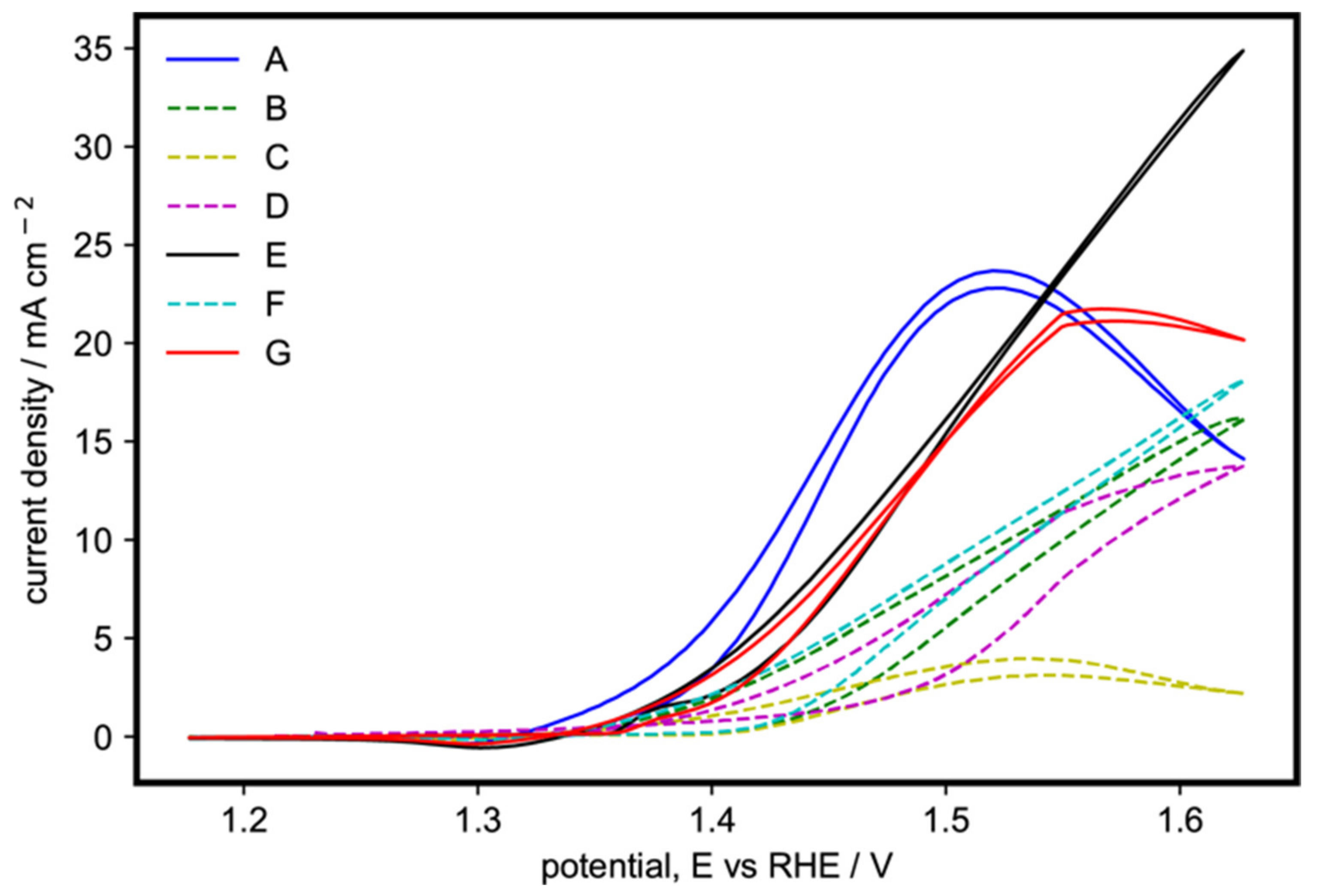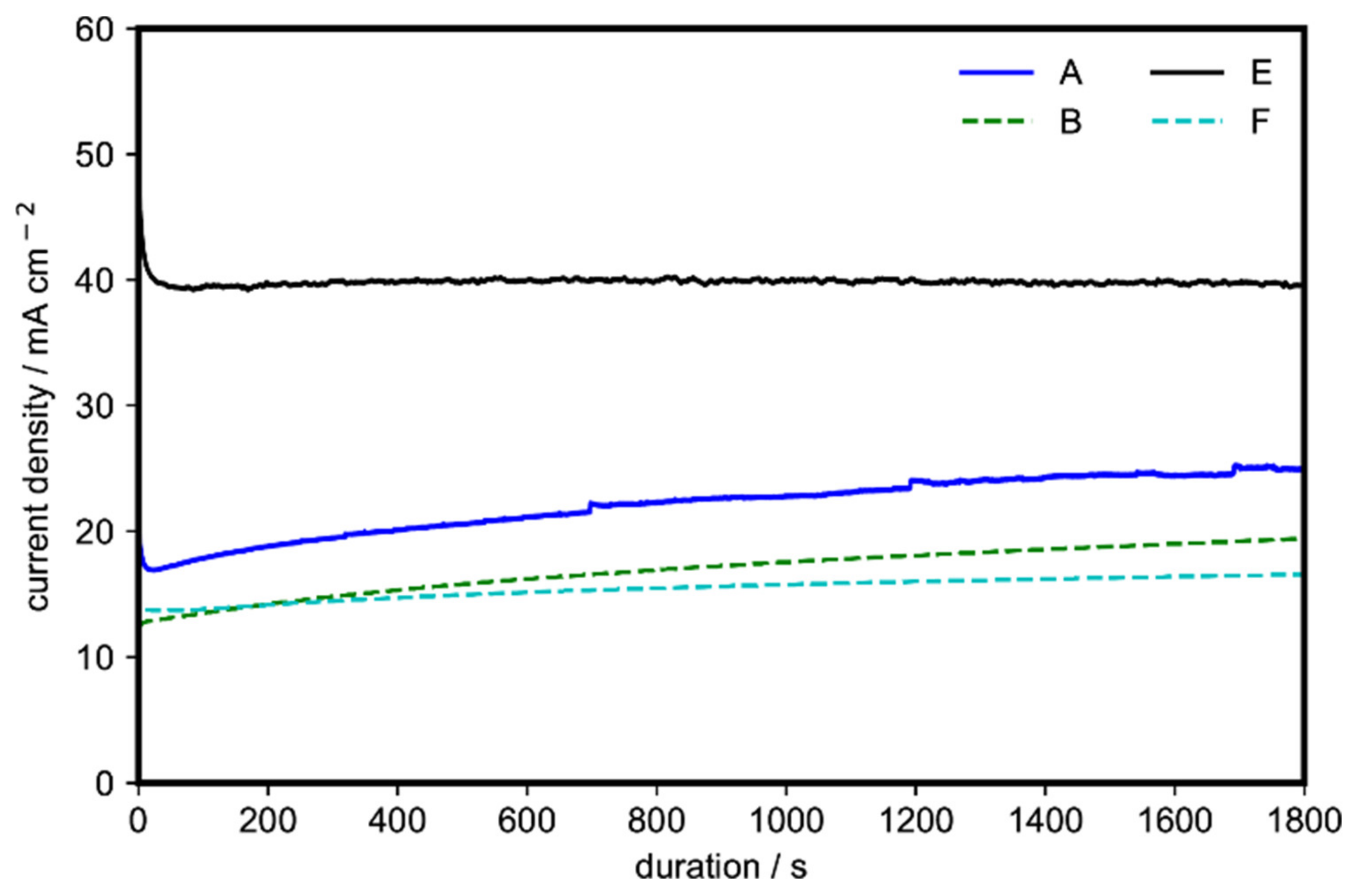Ethanol Electrooxidation on Phase- and Morphology-Controlled Ni(OH)2 Microspheres
Abstract
1. Introduction
2. Results
3. Materials and Methods
3.1. Chemicals and Materials
3.2. Synthesis of Ni(OH)2 Catalysts
3.3. Characterization
3.4. Electrochemical Measurements
4. Conclusions
Supplementary Materials
Author Contributions
Funding
Conflicts of Interest
References
- Baykara, S.Z.Z. Hydrogen: A brief overview on its sources, production and environmental impact. Int. J. Hydrog. Energy 2018, 43, 10605–10614. [Google Scholar] [CrossRef]
- Barbir, F. PEM electrolysis for production of hydrogen from renewable energy sources. Sol. Energy 2005, 78, 661–669. [Google Scholar] [CrossRef]
- Badwal, S.P.S.; Giddey, S.S.; Munnings, C.; Bhatt, A.I.; Hollenkamp, A.F. Emerging electrochemical energy conversion and storage technologies. Front. Chem. 2014, 2, 1–28. [Google Scholar] [CrossRef]
- Kamarudin, M.Z.F.; Kamarudin, S.K.; Masdar, M.S.; Daud, W.R.W. Review: Direct ethanol fuel cells. Int. J. Hydrog. Energy 2013, 38, 9438–9453. [Google Scholar] [CrossRef]
- Badwal, S.P.S.; Giddey, S.; Kulkarni, A.; Goel, J.; Basu, S. Direct ethanol fuel cells for transport and stationary applications—A comprehensive review. Appl. Energy 2015, 145, 80–103. [Google Scholar] [CrossRef]
- Lamy, C.; Jaubert, T.; Baranton, S.; Coutanceau, C. Clean hydrogen generation through the electrocatalytic oxidation of ethanol in a Proton Exchange Membrane Electrolysis Cell (PEMEC): Effect of the nature and structure of the catalytic anode. J. Power Sources 2014, 245, 927–936. [Google Scholar] [CrossRef]
- Kavanagh, R.; Cao, X.M.; Lin, W.F.; Hardacre, C.; Hu, P. Origin of low CO 2 selectivity on platinum in the direct ethanol fuel cell. Angew. Chem. Int. Ed. 2012, 51, 1572–1575. [Google Scholar] [CrossRef]
- Camara, G.A.; Iwasita, T. Parallel pathways of ethanol oxidation: The effect of ethanol concentration. J. Electroanal. Chem. 2005, 578, 315–321. [Google Scholar] [CrossRef]
- Monyoncho, E.A.; Steinmann, S.N.; Sautet, P.; Baranova, E.A.; Michel, C. Computational screening for selective catalysts: Cleaving the C–C bond during ethanol electro-oxidation reaction. Electrochim. Acta 2018, 274, 274–278. [Google Scholar] [CrossRef]
- Wang, H.; Jusys, Z.; Behm, R.J. Ethanol Electrooxidation on a Carbon-Supported Pt Catalyst: Reaction Kinetics and Product Yields. J. Phys. Chem. B 2004, 108, 19413–19424. [Google Scholar] [CrossRef]
- Akhairi, M.A.F.; Kamarudin, S.K. Catalysts in direct ethanol fuel cell (DEFC): An overview. Int. J. Hydrog. Energy 2016, 41, 4214–4228. [Google Scholar] [CrossRef]
- Zignani, S.C.; Baglio, V.; Linares, J.J.; Monforte, G.; Gonzalez, E.R.; Aricò, A.S. Endurance study of a solid polymer electrolyte direct ethanol fuel cell based on a Pt–Sn anode catalyst. Int. J. Hydrog. Energy 2013, 38, 11576–11582. [Google Scholar] [CrossRef]
- Del Rosario, J.A.D.; Ocon, J.D.; Jeon, H.; Yi, Y.; Lee, J.K.; Lee, J. Enhancing Role of Nickel in the Nickel–Palladium Bilayer for Electrocatalytic Oxidation of Ethanol in Alkaline Media. J. Phys. Chem. C 2014, 118, 22473–22478. [Google Scholar] [CrossRef]
- Ma, L.; He, H.; Hsu, A.; Chen, R. PdRu/C catalysts for ethanol oxidation in anion-exchange membrane direct ethanol fuel cells. J. Power Sources 2013, 241, 696–702. [Google Scholar] [CrossRef]
- Zhang, Z.; Xin, L.; Sun, K.; Li, W. Pd–Ni electrocatalysts for efficient ethanol oxidation reaction in alkaline electrolyte. Int. J. Hydrog. Energy 2011, 36, 12686–12697. [Google Scholar] [CrossRef]
- He, Y.; Yan, D.; Wang, S.; Shi, L.; Zhang, X.; Yan, K.; Luo, H. Topological Type-II Dirac Semimetal and Superconductor PdTe2 for Ethanol Electrooxidation. Energy Technol. 2019, 7, 1–6. [Google Scholar] [CrossRef]
- Zhou, L.; Xie, X.; Xie, R.; Guo, H.; Wang, M.; Wang, L. Facile synthesis of AuPd nanowires anchored on the hybrid of layered double hydroxide and carbon black for enhancing catalytic performance towards ethanol electro-oxidation. Int. J. Hydrog. Energy 2019, 44, 25589–25598. [Google Scholar] [CrossRef]
- Chen, Y.; Zhuang, L.; Lu, J. Non-Pt Anode Catalysts for Alkaline Direct Alcohol Fuel Cells. Chin. J. Catal. 2007, 28, 870–874. [Google Scholar] [CrossRef]
- Oh, Y.; Kim, S.K.S.; Peck, D.H.D.; Jang, J.S.J.J.S.; Kim, J.; Jung, D.H. ScienceDirect Improved performance using tungsten carbide/carbon nanofiber based anode catalysts for alkaline direct ethanol fuel cells. Int. J. Hydrog. Energy 2014, 39, 4–9. [Google Scholar] [CrossRef]
- Cao, L.; Sun, G.; Li, H.; Xin, Q. Carbon-supported IrSn catalysts for a direct ethanol fuel cell. Electrochem. Commun. 2007, 9, 2541–2546. [Google Scholar] [CrossRef]
- Kiani, M.A.; Mousavi, M.F.; Ghasemi, S. Size effect investigation on battery performance: Comparison between micro- and nano-particles of  -Ni (OH) 2 as nickel battery cathode material. J. Power Sources 2010, 195, 5794–5800. [Google Scholar] [CrossRef]
- Rajamathi, M.; Kamath, P.V. On the relationship between α-nickel hydroxide and the basic salts of nickel. J. Power Sources 1998, 70, 118–121. [Google Scholar] [CrossRef]
- Dong, L.; Chu, Y.; Sun, W. Controllable synthesis of nickel hydroxide and porous nickel oxide nanostructures with different morphologies. Chem. A Eur. J. 2008, 14, 5064–5072. [Google Scholar] [CrossRef] [PubMed]
- Jafarian, M.; Forouzandeh, F.; Danaee, I.; Gobal, F.; Mahjani, M.G. Electrocatalytic oxidation of glucose on Ni and NiCu alloy modified glassy carbon electrode. J. Solid State Electrochem. 2009, 13, 1171–1179. [Google Scholar] [CrossRef]
- Danaee, I.; Jafarian, M.; Forouzandeh, F.; Gobal, F.; Mahjani, M.G. Electrocatalytic oxidation of methanol on Ni and NiCu alloy modified glassy carbon electrode. Int. J. Hydrog. Energy 2008, 33, 4367–4376. [Google Scholar] [CrossRef]
- Barbosa, A.F.B.; Oliveira, V.L.; van Drunen, J.; Tremiliosi-Filho, G. Ethanol electro-oxidation reaction using a polycrystalline nickel electrode in alkaline media: Temperature influence and reaction mechanism. J. Electroanal. Chem. 2015, 746, 31–38. [Google Scholar] [CrossRef]
- Hutton, L.A.; Vidotti, M.; Patel, A.N.; Newton, M.E.; Unwin, P.R.; Macpherson, J.V. Electrodeposition of Nickel Hydroxide Nanoparticles on Boron-Doped Diamond Electrodes for Oxidative Electrocatalysis. J. Phys. Chem. C 2011, 115, 1649–1658. [Google Scholar] [CrossRef]
- Fleischmann, M.; Korinek, K.; Pletcher, D. The oxidation of organic compounds at a nickel anode in alkaline solution. J. Electroanal. Chem. Interfacial Electrochem. 1971, 31, 39–49. [Google Scholar] [CrossRef]
- Motheo, A.J.; Machado, S.A.S.; Rabelo, F.J.B.; Santos, J.R.J. Electrochemical study of ethanol oxidation on nickel in alkaline media.pdf. J. Braz. Chem. Soc. 1994, 5, 161–165. [Google Scholar] [CrossRef]
- Hall, D.S.; Lockwood, D.J.; Bock, C.; MacDougall, B.R. Nickel hydroxides and related materials: A review of their structures, synthesis and properties. Proc. R. Soc. A Math. Phys. Eng. Sci. 2014, 471, 20140792. [Google Scholar] [CrossRef]
- Gao, M.; Sheng, W.; Zhuang, Z.; Fang, Q.; Gu, S.; Jiang, J.; Yan, Y. Efficient water oxidation using nanostructured α-nickel-hydroxide as an electrocatalyst. J. Am. Chem. Soc. 2014, 136, 7077–7084. [Google Scholar] [CrossRef] [PubMed]
- Aghazadeh, M.; Ghaemi, M.; Sabour, B.; Dalvand, S. Electrochemical preparation of α-Ni(OH)2 ultrafine nanoparticles for high-performance supercapacitors. J. Solid State Electrochem. 2014, 18, 1569–1584. [Google Scholar] [CrossRef]
- Mourdikoudis, S.; Liz-Marzán, L.M. Oleylamine in Nanoparticle Synthesis. Chem. Mater. 2013, 25, 1465–1476. [Google Scholar] [CrossRef]
- Xu, L.; Ding, Y.Y.S.; Chen, C.C.H.; Zhao, L.; Rimkus, C.; Joesten, R.; Suib, S.L.L. 3D Flowerlike α-Nickel Hydroxide with Enhanced Electrochemical Activity Synthesized by Microwave-Assisted Hydrothermal Method. Chem. Mater. 2008, 20, 308–316. [Google Scholar] [CrossRef]
- Shen, S.Y.; Zhao, T.S.; Xu, J.B.; Li, Y.S. Synthesis of PdNi catalysts for the oxidation of ethanol in alkaline direct ethanol fuel cells. J. Power Sources 2010, 195, 1001–1006. [Google Scholar] [CrossRef]
- Du, W.; Mackenzie, K.E.; Milano, D.F.; Deskins, N.A.; Su, D.; Teng, X. Palladium–Tin Alloyed Catalysts for the Ethanol Oxidation Reaction in an Alkaline Medium. ACS Catal. 2012, 2, 287–297. [Google Scholar] [CrossRef]
- Vidotti, M.; Torresi, R.; De Torresi, S.I.C. Nickel hydroxide modified electrodes: A review study concerning its structural and electrochemical properties aiming the application in electrocatalysis, electrochromism and secondary batteries [Eletrodos modificados por hidróxido de níquel: Um estudo de]. Quim. Nova 2010, 33, 2176–2186. [Google Scholar] [CrossRef]




| Sample | Morphology | Dominant Crystal Phase | Microsphere Diameter | Nanoflake Thickness |
|---|---|---|---|---|
| A | Nanoflakes arranged in a 3D flowerlike structure | α | NA | (indeterminate due to angle in SEM image) |
| B | Microspheres with nanoflakes | α/β mixture | 2.44–6.87 µm | ~50 nm |
| C | Microspheres with nanoflakes | β | 2.45–5.35 µm | |
| D | Nanoflakes | α/β mixture | NA | |
| E | Microspheres with nanoflakes | α | 0.70–1.40 µm | |
| F | Nanoflakes | α/β mixture | NA | |
| G | Microspheres with nanoflakes | α | 0.70–5.93 µm |
| Anode catalyst | Potential a | Ethanol Concentration | Electrolyte | Current Density (mA cm−2) | Reference |
|---|---|---|---|---|---|
| Sample E | 1.55 V vs. RHE (0.53V vs. Ag/AgCl) b | 1 M | 1 M KOH | 24.4 | this work |
| Sample A | 1.52 V vs. RHE (0.51 V vs. Ag/AgCl) | 1 M | 1 M KOH | 23.7 | |
| Polycrystalline Ni foam | 1.55 V vs. RHE | 0.5 M | 1 M NaOH | 16.3 | [26] |
| Ni-B nanotubes | 0.60 V vs. Ag/AgCl | 0.5 M | 0.1 M NaOH | 19.2 | [27] |
| NiPd/Ti | −0.19 V vs. Hg/HgO | 1 M | 1 M KOH | ~2.5 | [13] |
| Pd86Sn14/C | −0.04V vs. Hg/HgO | 0.5 M | 0.5 M KOH | 8.4 | [36] |
| Pd2Ni3/C | −0.13 V vs. Hg/HgO | 1 M | 1 M KOH | 217 | [35] |
© 2020 by the authors. Licensee MDPI, Basel, Switzerland. This article is an open access article distributed under the terms and conditions of the Creative Commons Attribution (CC BY) license (http://creativecommons.org/licenses/by/4.0/).
Share and Cite
Lidasan, J.J.B.; del Rosario, J.A.D.; Ocon, J.D. Ethanol Electrooxidation on Phase- and Morphology-Controlled Ni(OH)2 Microspheres. Catalysts 2020, 10, 740. https://doi.org/10.3390/catal10070740
Lidasan JJB, del Rosario JAD, Ocon JD. Ethanol Electrooxidation on Phase- and Morphology-Controlled Ni(OH)2 Microspheres. Catalysts. 2020; 10(7):740. https://doi.org/10.3390/catal10070740
Chicago/Turabian StyleLidasan, Jun Jeffri B., Julie Anne D. del Rosario, and Joey D. Ocon. 2020. "Ethanol Electrooxidation on Phase- and Morphology-Controlled Ni(OH)2 Microspheres" Catalysts 10, no. 7: 740. https://doi.org/10.3390/catal10070740
APA StyleLidasan, J. J. B., del Rosario, J. A. D., & Ocon, J. D. (2020). Ethanol Electrooxidation on Phase- and Morphology-Controlled Ni(OH)2 Microspheres. Catalysts, 10(7), 740. https://doi.org/10.3390/catal10070740






